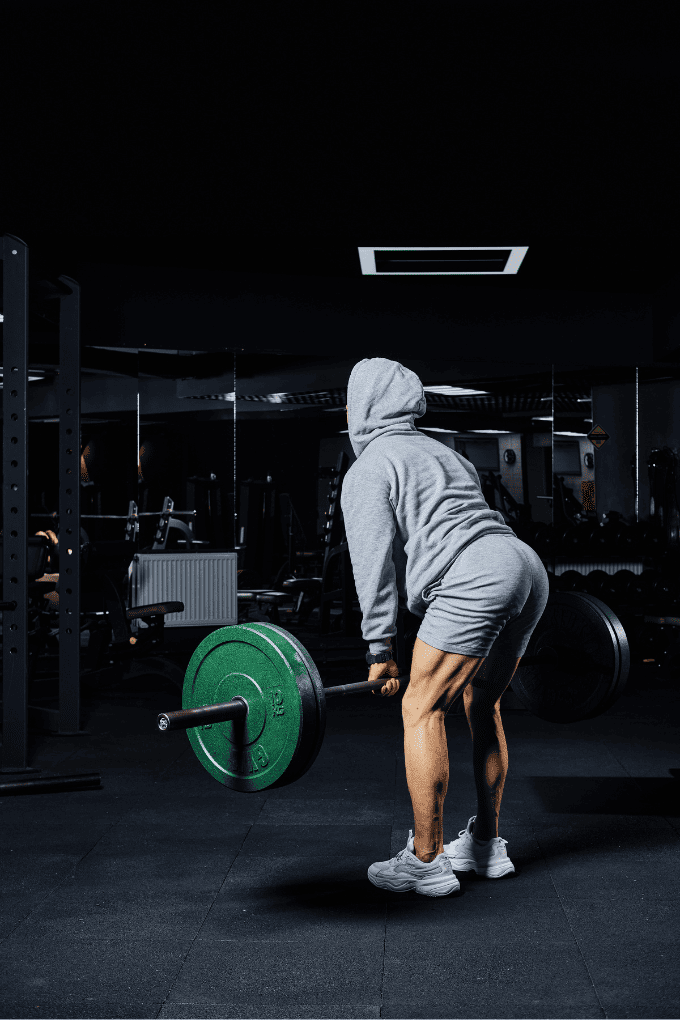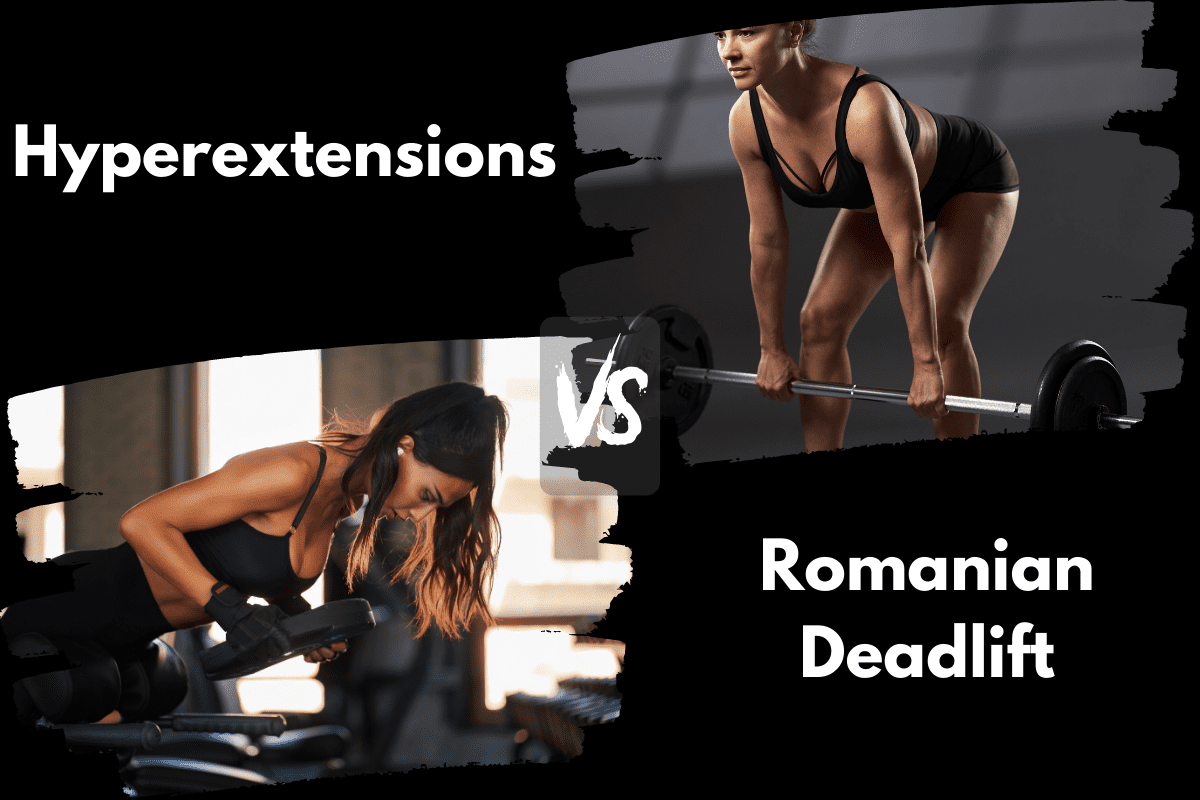Hyperextensions vs Romanian Deadlift (Which is Better?)
When it comes to targeting the muscles of the posterior chain, two exercises often come to mind: Hyperextensions and Romanian Deadlifts (RDLs). Both exercises are popular choices for athletes and weightlifters who want to strengthen their glutes, hamstrings, and lower back.
While both exercises are effective, they have unique differences in terms of their mechanics, execution, and the equipment they require.
In this article, I’ll dive deeper into the differences between Hyperextensions and RDLs, examining their benefits, drawbacks, and how they can be used in a well-rounded training program.
Hyperextensions

Equipment Needed
- Glute-Ham Raise Machine
Step-by-Step Instruction
- First, you are going to want to get the glute-ham raise machine adjusted to the correct length.
- I recommend adjusting the machine so that your hip crease is at the end of the padding of the machine.
- Locking your feet in, facing the ground, keep a neutral spine by focusing your eyes on the floor below.
- Take in a deep breath, brace the abdomen, and keep your hands on the handles until you are ready to perform the eccentric movement.
- Once ready, take your hands off the handles, extend your body, keep your arms at your side, and control your body down until your torso is about perpendicular to the floor.
- Pause for 1 second in the bottom of the position to maintain stiffness in the muscles before coming back up.
- After 1 second of the isometric hold, pull yourself back parallel to the floor, engaging the glutes, hamstrings, and low back, while also keeping stiffness in the abdomen and upper back.
Coaching Points
Hyperextensions are surprisingly easy to mess up. One of the easiest ways to make a mistake is going down too fast and “whipping” yourself back to the starting position. As with any exercise, the setup, initial breath before eccentric movement, maintaining control, pausing, and breathing out during concentric contraction are important.
Hyperextensions are a great movement to use for accessory work after the main work is done for the session, warm-ups, and rehabilitation.
RELATED –> My 11 favorite Hyperextension alternatives
It is important for the lifter to maintain a neutral spine, maintaining tension in the abdomen and upper back. Remember to breathe in and hold the breath during eccentric (lowering your body) and breathe out as you perform the concentric movement (bringing your body back up).
Benefits of Hyperextensions
Many people only think of the abs when referring to the core, but the low back is an important part of the core.
Along with the glutes and hamstrings, hyperextensions work the erector spinae muscles, which are the muscles that run along the spine and are responsible for extending the back. By strengthening these muscles, hyperextensions can help improve performance in larger compound movements like Back Squats and Olympic lifts.
Strengthening the lower back and core muscles through hyperextensions can also help prevent injuries and improve overall physical performance for sports or even just daily activities.

Tired of coming up with your own workouts? But don’t want to pay an arm and a leg?
I post workouts 5 days a week right here. (Did I mention they’re free?)
Romanian Deadlifts

Equipment Needed
- Barbell
- Weight Plates (Bumper or Iron)
How To
- Address the bar with feet shoulder-width apart, and toes straight ahead.
- Use a pronated grip about a thumb length from the start of the knurling.
- Now, with a good flat back, pick the bar up to a standing position.
- From here, put a slight bend in the knees and ‘set the back’ by squeezing the shoulder blades and engaging the lats.
- Brace the core and hinge forward by pushing the hips back.
- The bar should almost drag right down the legs, across the knees and straight down the shins. The whole foot should stay flat on the ground, but the weight should be on the mid-foot to heel.
- Maintain the neutral spine position throughout the descent and once you feel a good stretch in the hamstrings, drive the hips forward (hip extension) and return to the starting position.
Coaching Points
The ‘depth’ that each person gets will be different and absolutely solely dependent upon hamstring flexibility.
Do NOT try to ‘reach’ the barbell toward the ground because you believe the plates should touch the floor. If you have tight hamstrings you may be doing well to get the bar to mid-shin. Trying to reach the bar to the floor will result in the lifter losing their neutral spine and rounding their back… which leads me right into common RDL mistakes.
Easily the most common mistake (and easily identifiable) that I see with athletes for a Romanian Deadlift is rounding the back. This is usually due to either poor technique or simply using too much weight. Use less weight if necessary and work on being able to keep the back engaged and the spine in a neutral position throughout the entire exercise.
Rounding the back puts a lot of stress on the spine and can be very dangerous if not corrected. This absolutely has to be a main point of emphasis.
Another common RDL mistake is excessive bending of the knee. Try to maintain a slight knee bend with all of the movement coming from the hip hinge. More bend in the knees basically turns the movement more into a conventional deadlift rather than an RDL.
RELATED –> 11 RDL alternatives for developing a strong posterior chain
Benefits of the RDL
The RDL, also referred to as a stiff leg deadlift, is a great exercise to work the posterior chain muscles, specifically the hamstrings, glutes and erector spinae of the low back.
Many of the movements that I utilize with athletes demand a very strong posterior chain (as does many sports movements as well). Olympic lifts, Back Squat and Front Squats are all great exercises for building strong, explosive athletes and all three demand a strong posterior chain.
Romanian deadlifts work as a terrific accessory lift to aid in the development of those bigger compound lifts.
Finally, the Romanian deadlift, as part of a holistic approach to strengthening the hamstrings and exposing the hamstrings to high-speed running can lower the risk of hamstring injuries.
Hyperextensions vs RDL: Which is Better?
Now, let’s take a side-by-side look at the two posterior chain exercises and discuss if one is better than the other for some common lifting goals.
Better for Developing Size and Strength: RDL

First off, let me be clear – both are excellent movements for improving strength and building muscle mass.
The reason I’m giving the edge to Romanian Deadlifts over Hypers is really more of a logistical issue than it is anything else. Let me explain.
With RDLs, you can pretty easily continue to add weight to the bar as you continue to become stronger. The same can’t be said for Hypers.
Yes, you can add resistance to Hyperextensions in the form of holding a plate or a dumbbell or even adding a resistance band. At some point though, it starts to become really difficult to continue adding resistance. This gives RDLs an advantage over Hypers.
Does that mean you should abandon Hypers in favor of RDLs?
Absolutely not. In fact, it will take many lifters quite a while before they can perform quality sets of ten with say, a 100-pound dumbbell, so Hypers are still a great exercise to have in your workouts. And, just as importantly, having both exercises in your strength program adds variety, a key element to a well-rounded program.
Better for Beginners: Toss Up
Both exercises have an argument to make for which is better for beginners.
I typically always go with a bodyweight exercise over one using a barbell (or even dumbbells) for a beginner. However, many beginners struggle with Hypers. Getting set up properly, getting over the uncomfortableness that normally comes with using a glute-ham developer, and even the movement itself – all can be difficult for a beginner.
Romanian Deadlifts, on the other hand, is a technical movement. Learning to hinge properly while maintaining a good flat back, braced core, keeping knees slightly bent, proper weight distribution on the feet – see where I’m going? RDLs can take some time to learn.
However, if a beginner can learn a proper RDL then it can lay the foundation for many other movements in the weight room like Olympic lifts and Deadlifts.
Regardless of which exercise you choose, always remember to focus on technique first and foremost, start light and then gradually start to increase in weight once your technique becomes proficient.

Get Shredded… For Free
Get a free workout Monday through Friday, posted right here on Horton Barbell. These workouts are designed to help you get strong, in shape and look great at the beach!
Final Thoughts
I just spent the back half of this article comparing if Hyperextensions or Romanian Deadlifts are better than the other. The truth is, assuming you have the proper equipment, there is no reason you can’t have both exercises in your strength training program.
Both exercises are effective and actually can complement each other well. Plus, by utilizing both exercises you can add variety to your workouts and keep them from getting stale.
So, my final suggestion is to figure out how you can incorporate both Hypers and RDLs into your training.
More Links and Info
Check out how Hyperextensions compare to other popular posterior chain exercises:

